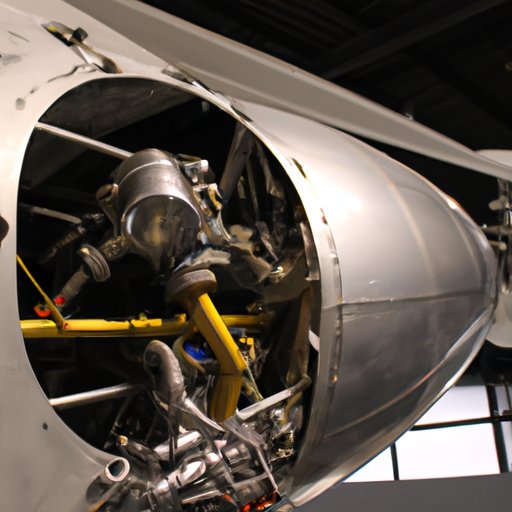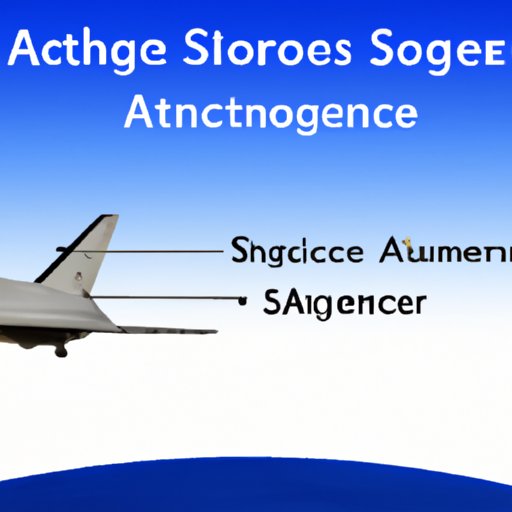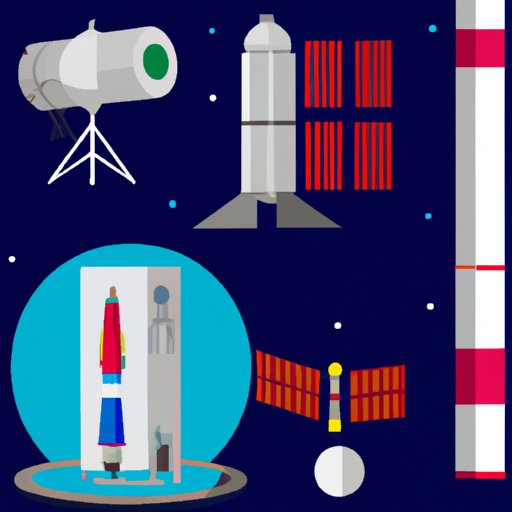Introduction
Aerospace science is a field of engineering and science that focuses on the development, design, and operation of aircraft, spacecraft, satellites, and missiles. It is a multidisciplinary field that combines elements of physics, electrical engineering, computer science, mathematics, and other sciences to create technologies that enable humans to explore space and fly safely through the atmosphere. In this article, we will explore the history and development of aerospace science, different fields of study within the field, its role in modern technology, benefits and challenges, and examine aerospace science as a potential career path.

Exploring the History and Development of Aerospace Science
The history of aerospace science dates back centuries, with the earliest forms of flight taking place in Ancient China. By the 15th century, Leonardo da Vinci had designed flying machines that were powered by springs and wheels, and in 1783, Joseph-Michael and Jacques-Etienne Montgolfier became the first people to fly in a hot air balloon. This marked the beginning of the modern era of aerospace science.
In the 19th century, several inventors created designs for heavier-than-air flying machines and achieved some success in building and flying them. The Wright Brothers are credited with being the first to successfully fly an airplane in 1903. Since then, there have been significant advances in aerospace science, including the development of rockets and missiles, the construction of satellites and space stations, and the exploration of other planets.
Exploring Different Fields of Aerospace Science
Aerospace science is a broad field that encompasses several different fields of study. These include astronautics, aeronautics, propulsion, space systems, and robotics.
Astronautics
Astronautics is the study of the design, construction, and operation of spacecraft and other objects used for space exploration. This includes the study of rocket propulsion, orbital mechanics, and communications systems. Astronautics also involves the study of the effects of spaceflight on the human body and the development of life support systems for astronauts.
Aeronautics
Aeronautics is the study of the design, construction, and operation of aircraft. This includes the study of aerodynamics, flight dynamics, control systems, materials science, and propulsion systems. Aeronautics also involves the study of how aircraft interact with the atmosphere, and how they can be designed to be more efficient and safe.
Propulsion
Propulsion is the study of how forces are generated to move a vehicle or object. This includes the study of jet engines, rocket engines, and other types of propulsion systems. Propulsion also involves the study of how these systems can be designed for maximum efficiency and safety.
Space Systems
Space systems is the study of the design, construction, and operation of satellites and other objects used for space exploration. This includes the study of navigation systems, communication systems, and power systems. Space systems also involves the study of how satellites can be designed to be more efficient and reliable.
Robotics
Robotics is the study of the design, construction, and operation of robotic systems. This includes the study of artificial intelligence, machine learning, and control systems. Robotics also involves the study of how robotic systems can be designed to be more autonomous and efficient.
Exploring the Role of Aerospace Science in Modern Technology
Aerospace science has played a major role in shaping modern technology. Its applications range from military uses, such as missiles and drones, to civilian applications, such as commercial airlines and spacecraft. Aerospace science has also enabled us to explore space and other worlds in ways that were previously impossible.
Aerospace Science in the Military
Aerospace science has been used extensively in the military for decades. Missiles and drones are two of the most common applications of aerospace science in the military. Missiles are powered by rocket engines and guided using advanced navigation systems. Drones are unmanned aerial vehicles (UAVs) that are remotely controlled by pilots on the ground.
Aerospace Science in Civilian Applications
Aerospace science is also used extensively in civilian applications. Commercial airlines use advanced aircraft designs and propulsion systems to make long-distance flights more efficient and safe. Spacecraft and satellites are used to facilitate communication, navigation, and surveillance.
Aerospace Science in Exploration
Aerospace science has enabled us to explore space and other worlds in ways that were previously impossible. Rockets and spacecraft have been used to send probes to distant planets and explore our solar system. We have also sent robotic rovers to Mars and other planets to study their surfaces and search for signs of life.

The Benefits and Challenges of Aerospace Science
Aerospace science provides many benefits, but it also poses certain challenges. Let’s take a look at some of the benefits and challenges of pursuing a career in aerospace science.
Benefits of Aerospace Science
Aerospace science offers numerous benefits, including the potential for a high salary, job security, and the chance to work on exciting projects. According to a study by the National Research Council, aerospace engineers earn an average salary of $100,000 per year. Additionally, the field is growing rapidly, with the Bureau of Labor Statistics predicting a 4% increase in jobs between 2018 and 2028. Finally, aerospace engineers often get the opportunity to work on cutting-edge projects, such as designing new aircraft or exploring other planets.
Challenges of Aerospace Science
Aerospace science also poses certain challenges. For example, the field requires a high level of technical knowledge and expertise, and the competition for jobs can be fierce. Additionally, the work can be stressful and demanding, and the cost of research and development can be high. Finally, aerospace engineers must constantly stay up to date with the latest advancements in the field.

Examining Aerospace Science as a Career Path
Aerospace science is a challenging but rewarding field that offers numerous job opportunities. Let’s take a look at some of the job opportunities available, as well as the education requirements and salary expectations.
Job Opportunities in Aerospace Science
Aerospace science offers a wide range of job opportunities, including positions in research, engineering, and manufacturing. Aerospace engineers may work in the defense industry, the commercial aviation industry, or the space exploration industry. Additionally, aerospace scientists may work in research laboratories or universities.
Education Requirements for Aerospace Science Careers
Most aerospace science jobs require at least a bachelor’s degree in a related field, such as aerospace engineering or aeronautical engineering. Some jobs may require a master’s degree or higher. Additionally, some employers may require certification from the Federal Aviation Administration.
Salary Expectations for Aerospace Science Careers
According to PayScale, the median salary for aerospace engineers is $92,070 per year. Salaries vary depending on experience and location, and some aerospace engineers may earn significantly more than the median. Additionally, most aerospace engineers receive bonuses and other benefits, such as health insurance and paid vacation time.
Conclusion
Aerospace science is a fascinating field that has enabled us to explore space and fly safely through the atmosphere. It is a multidisciplinary field that combines elements of physics, electrical engineering, computer science, mathematics, and other sciences. Aerospace science offers numerous job opportunities, with salaries ranging from $60,000 to over $100,000 per year. However, the field requires a high level of technical knowledge and expertise, and the competition for jobs can be fierce. Nevertheless, for those who are passionate about aerospace science, the rewards can be great.
If you’re interested in pursuing a career in aerospace science, you should start by researching the field and familiarizing yourself with the different fields of study. You should also consider pursuing an internship or apprenticeship to gain hands-on experience. Finally, you should look into educational opportunities, such as college degree programs, to give you the skills and knowledge needed to succeed in the field.
For more information about aerospace science, check out the following resources:
- NASA Glenn Research Center
- NASA
- Federal Aviation Administration
- American Institute of Aeronautics and Astronautics
Aerospace science is an ever-evolving field that offers numerous job opportunities and the chance to work on exciting projects. With the right skills and knowledge, aerospace science can be a fulfilling and rewarding career path.
(Note: Is this article not meeting your expectations? Do you have knowledge or insights to share? Unlock new opportunities and expand your reach by joining our authors team. Click Registration to join us and share your expertise with our readers.)
